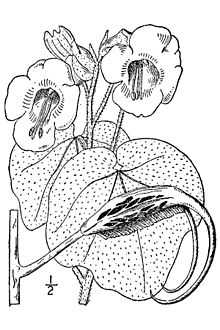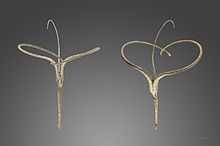Proboscidea (plant)
| Proboscidea | |
|---|---|
 | |
| Botanical drawing of Proboscidea louisianica | |
| Scientific classification | |
| Kingdom: | Plantae |
| (unranked): | Angiosperms |
| (unranked): | Eudicots |
| (unranked): | Asterids |
| Order: | Lamiales |
| Family: | Martyniaceae |
| Genus: | Proboscidea Schmidel |
| Species | |
|
See text. | |
Proboscidea is a genus of flowering plant in the family Martyniaceae, some of whose species are known as devil's claw, devil's horn, ram's horn, or unicorn plant. The plants produce long, hooked seed pods. The hooks catch on the feet of animals, and as the animals walk, the pods are ground or crushed open, dispersing the seeds. The name devil's claw is shared with the South African plant Harpagophytum procumbens.
Uses
The fruits of all species are edible before they ripen and become woody, they can be steamed and eaten much like okra. Some species (particularly P. parviflora) are used in basket weaving by the Tohono O'odham who have selected for varieties with longer "claws."[1] The Hia ced O'odham and the Tohono O'odham eat the seeds, in ancient times seeds provided an important source of dietary oils.
Lepidoptera
Two species of Proboscidea that grow in Arizona are the only known hosts of Manduca sexta (tomato hornworm) outside the family Solanaceae.[2]
Species
Species include:
- Proboscidea althaeifolia - devil's horn, devil's claw, or desert unicorn plant
- Proboscidea louisianica - ram's horn
- Proboscidea parviflora - doubleclaw, (red) devil's claw
- Proboscidea sabulosa - dune unicorn plant
- Proboscidea spicata - New Mexico unicorn plant
Proboscidea lutea is a synonym of Ibicella lutea.
-

P. louisianica
-

P. parviflora
-

Flower of P. parviflora ssp. parviflora var. hohokamiana[1]
-

"Devil's claw" fruits of P. parviflora var. hohokamiana
-

"Devil's claw" capsule of Proboscidea althaeifolia
-

Proboscidea parviflora - capsule and seeds - MHNT
-

Proboscidea parviflora var.hohokamiana - capsule and seeds - MHNT
Cite error: There are <ref> tags on this page, but the references will not show without a {{reflist}} template (see the help page).
References
- ↑ Devils Claws
- ↑ Mechaber, W. L. and J. G. Hildebrand. 2000. Novel, non-solanaceous hostplant record for Manduca sexta (Lepidoptera: Sphingidae) in the southwestern United States. Annals of the Entomological Society of America 93(3):447-451.
External links
| ||||||||||||||